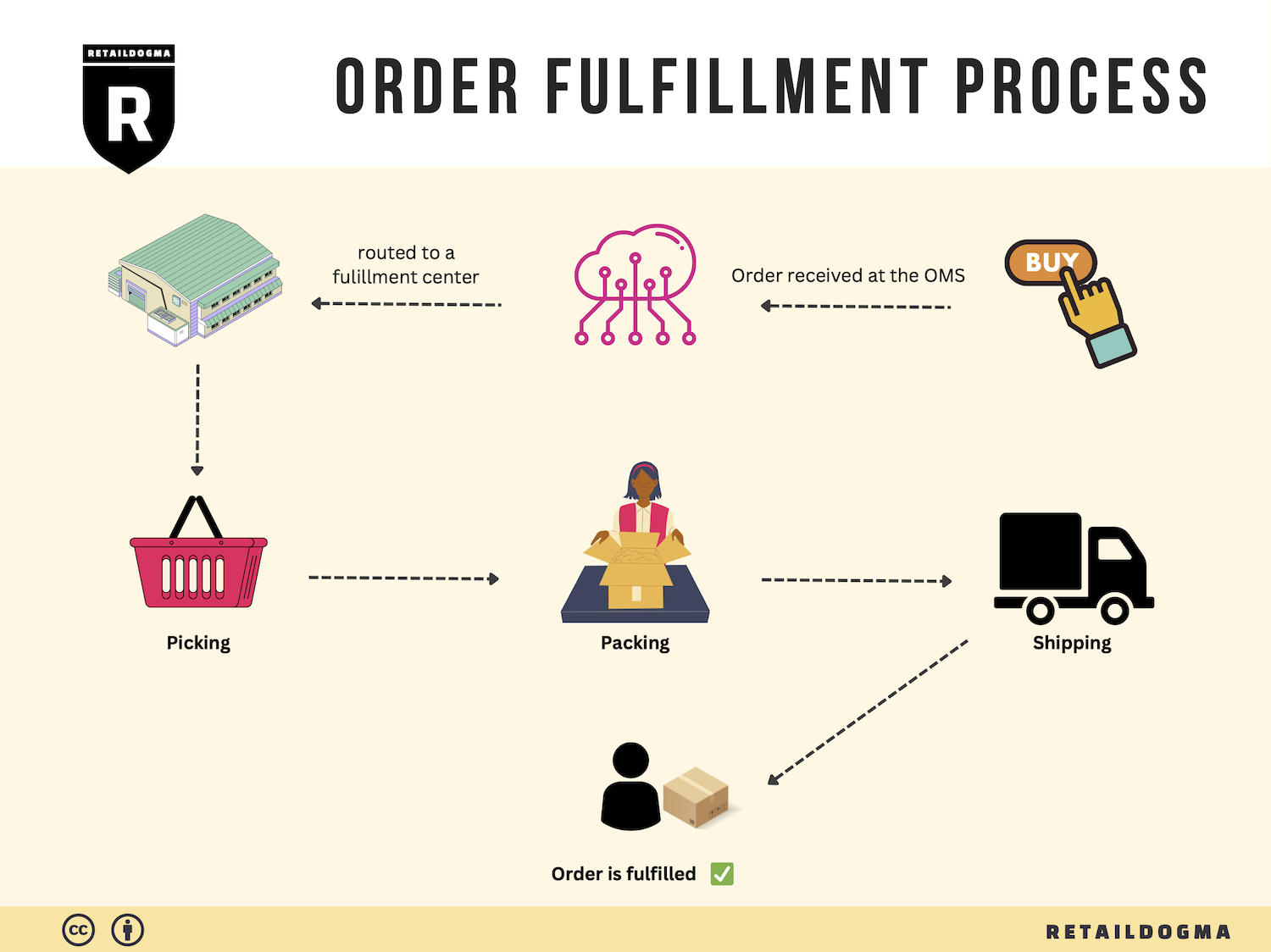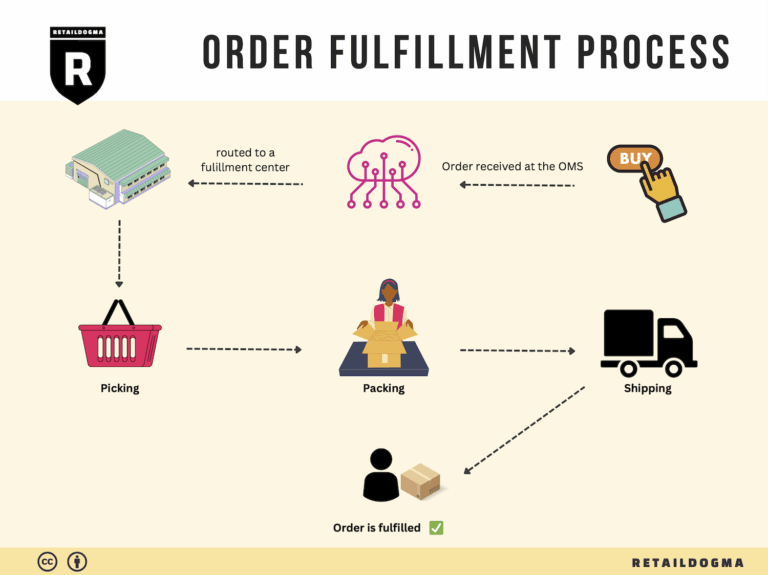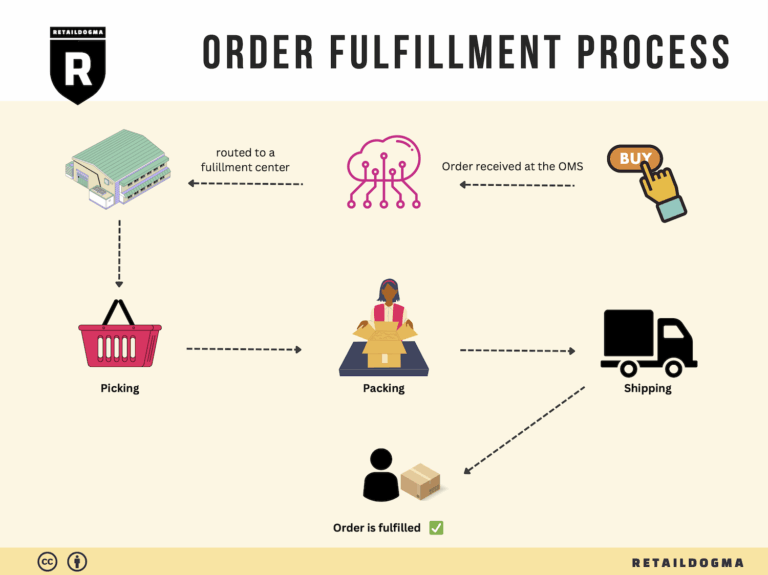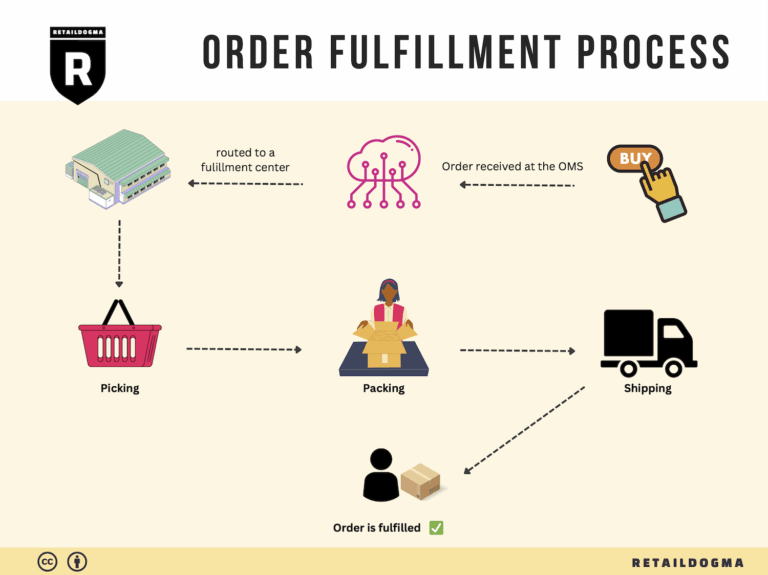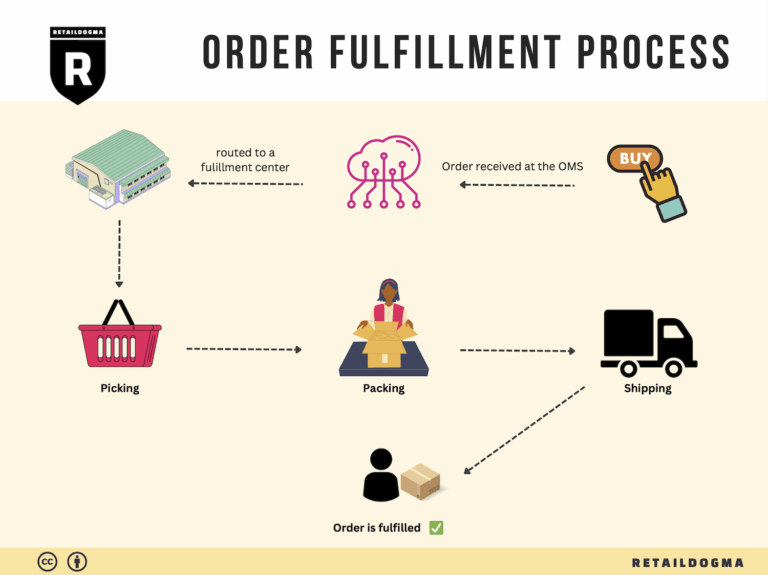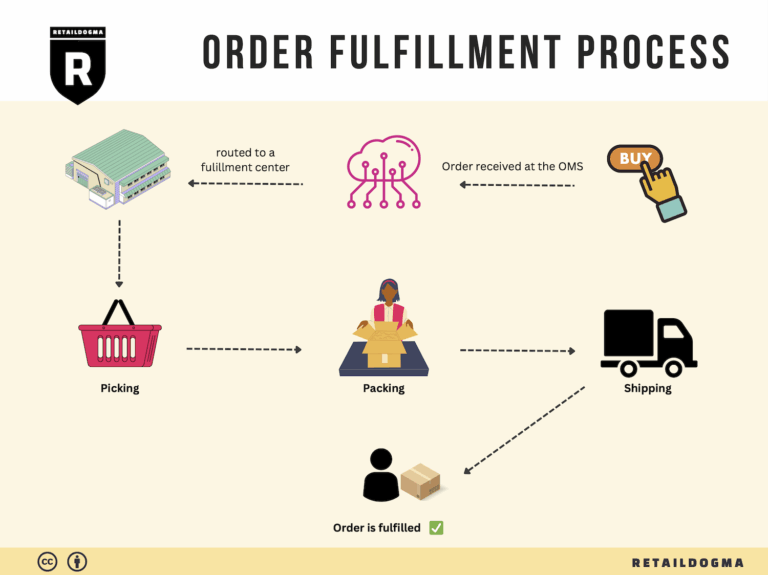How Order Fulfillment Works: A Step-by-Step Guide for Businesses
What is E-commerce Fulfillment? An Introduction for Growing Businesses
Understanding E-commerce Fulfillment: A Key to Scaling Your Business
As an e-commerce business owner, you may find yourself overwhelmed by the complexities of packing and shipping orders. The excitement of increasing sales can quickly turn into a logistical nightmare if you’re not equipped to handle the fulfillment process efficiently. Fulfillment is essentially the backbone of your online business—it encompasses all the steps involved in getting a product from your warehouse to your customer’s doorstep. From inventory management to shipping logistics, mastering this process is crucial for sustaining growth and enhancing customer satisfaction.
This guide aims to demystify e-commerce fulfillment and provide you with the knowledge necessary to streamline your operations. We will cover various fulfillment models, such as Third-Party Logistics (3PL) and Fulfillment by Amazon (FBA). Each model has unique advantages and challenges, and understanding these can help you align your fulfillment strategy with your business goals.
Additionally, we’ll delve into the core services that fulfillment partners typically offer, including storage, picking, packing, shipping, and returns management. Knowing what to expect from a fulfillment partner will empower you to make informed decisions when selecting the right one for your business.
Choosing the right fulfillment partner is a critical step in optimizing your logistics. We’ll provide practical tips on what to consider when evaluating potential partners, such as their location, technology capabilities, service offerings, and customer support. The right fit can not only improve your operational efficiency but also enhance your customer experience.
Finally, we’ll discuss pricing structures commonly used in the fulfillment industry. Understanding how fulfillment costs are calculated—whether by volume, weight, or service level—will allow you to budget effectively and avoid unexpected expenses.
The ultimate goal of this guide is to empower you to make smart, strategic decisions about your logistics. By understanding the ins and outs of e-commerce fulfillment, you can focus on what you do best: growing your business and delighting your customers. With the right fulfillment strategy in place, you can turn the challenges of packing and shipping into a streamlined process that supports your growth ambitions.
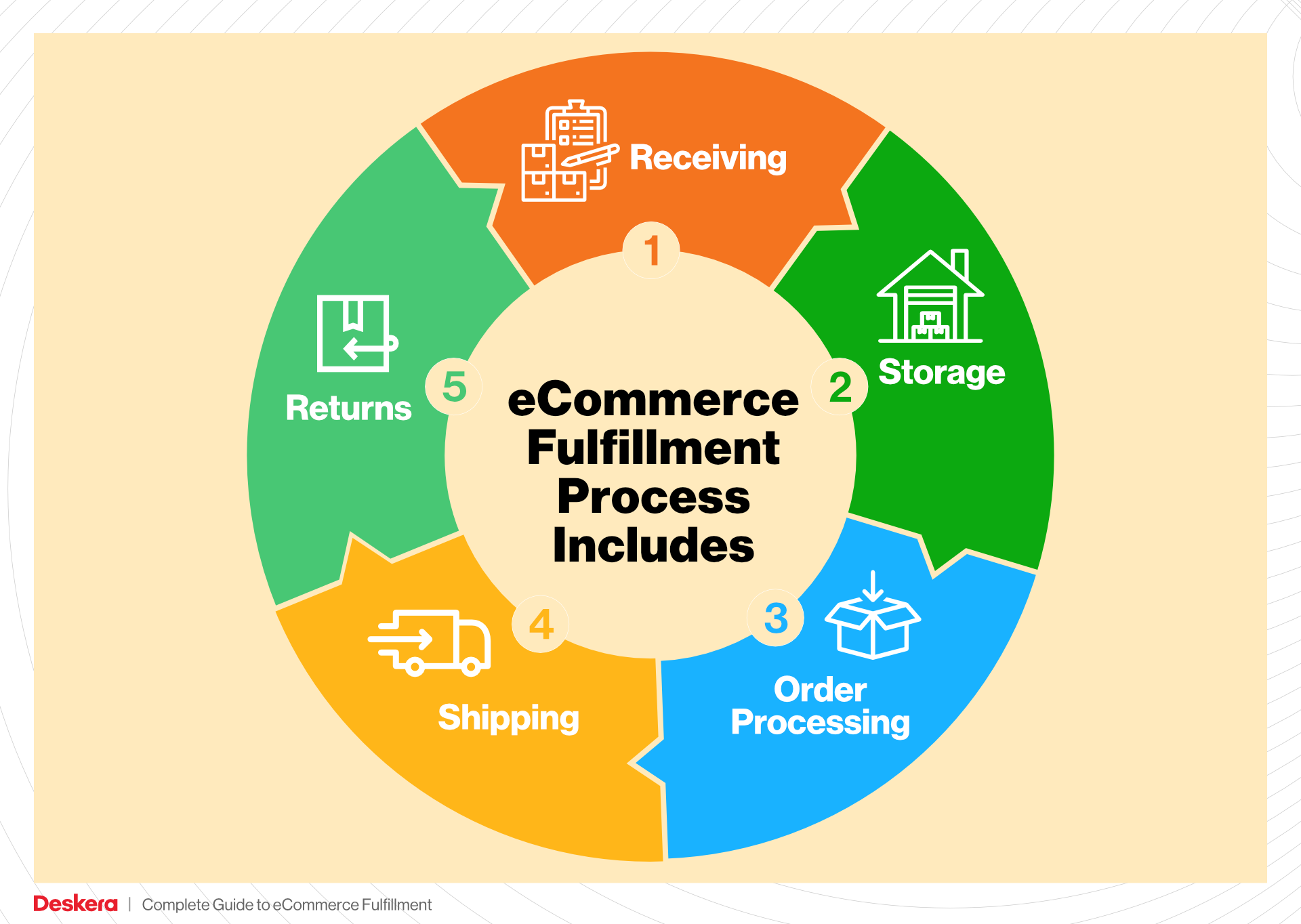
What You’ll Learn In This Guide
- What is E-commerce Fulfillment? An Introduction for Growing Businesses
- The Order Fulfillment Process: From ‘Buy’ Button to Customer’s Door
- Comparing Fulfillment Models: In-House vs. 3PL vs. Dropshipping
- A Deep Dive into Amazon FBA: Pros, Cons, and Who It’s For
- Core Services Offered by Fulfillment Centers
- How to Choose a Fulfillment Partner: A 6-Point Checklist
- Understanding Fulfillment Pricing: A Breakdown of Common Fees
- Frequently Asked Questions (FAQs) about Fulfillment
- Conclusion: Is Outsourcing Fulfillment the Right Move for Your Business?
- Important Disclaimer
The Order Fulfillment Process: From ‘Buy’ Button to Customer’s Door
1. Receiving Inventory
The order fulfillment process begins with receiving inventory from suppliers or manufacturers. During this stage, products are checked for quality and quantity against purchase orders. Each item is assigned a Stock Keeping Unit (SKU), which is a unique identifier that helps track inventory levels and manage stock more efficiently.
Importance: Properly receiving inventory is crucial as it sets the foundation for accurate inventory management. Any discrepancies at this stage can lead to stockouts or overstock situations, affecting overall operations and customer satisfaction. Efficient receiving practices help ensure that products are available for order fulfillment when needed.
2. Warehouse Storage
Once inventory is received and checked, it is stored in designated locations within the warehouse. Effective warehouse management involves organizing products in a way that maximizes space and facilitates easy access. Key terms in this step include “bin locations” and “inventory management systems,” which help track where items are stored.
Importance: Strategic warehouse storage is vital for optimizing picking efficiency. By categorizing products based on demand, size, or type, businesses can reduce the time taken to locate items for orders. A well-organized storage system not only speeds up the order fulfillment process but also minimizes errors and enhances overall productivity.
3. Order Picking
When a customer places an order, the next step is order picking, where warehouse staff gather the items specified in the order. This process often utilizes pick lists, which are documents that outline the items to be retrieved, including their locations. Various picking methods, such as single order picking or batch picking, may be employed based on the volume of orders.
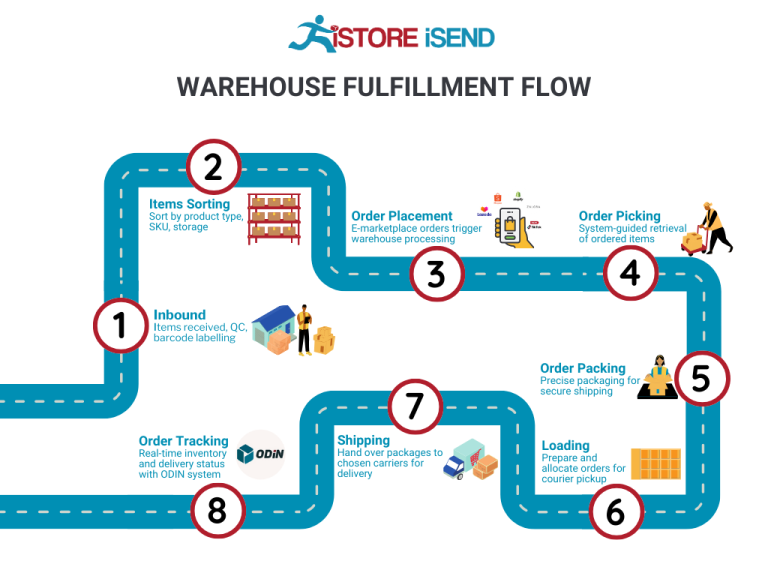
Importance: Order picking is a critical step that directly impacts fulfillment speed and accuracy. The efficiency of this process can significantly affect customer satisfaction, as timely and correct order fulfillment leads to positive shopping experiences. Implementing technology, such as barcode scanners or pick-to-light systems, can further enhance picking efficiency and reduce errors.
4. Order Packing
After items are picked, they move on to the packing stage, where they are prepared for shipment. This involves checking items against the order to ensure accuracy, as well as selecting appropriate packaging materials to protect products during transit. Key considerations include weight, dimensions, and fragility of items, which can influence shipping costs and methods.
Importance: Proper packing is essential for preventing damage during transportation and ensuring that customers receive their orders in pristine condition. Additionally, efficient packing processes can reduce shipping costs by optimizing box sizes and minimizing wasted space. Incorporating automated packing solutions can streamline this step, further enhancing operational efficiency.
5. Shipping & Delivery
The final stage of the order fulfillment process is shipping and delivery. Once packed, orders are labeled and dispatched to carriers for delivery to customers. Tracking numbers are often provided, allowing customers to monitor their shipment’s progress. Key terms in this stage include “last-mile delivery” and “shipping logistics,” which refer to the final leg of the delivery process and the coordination of transportation resources, respectively.
Importance: Effective shipping and delivery practices are crucial for customer satisfaction and retention. Timely delivery enhances the overall shopping experience, while reliable tracking information builds trust between the customer and the business. By partnering with reputable carriers and utilizing advanced shipping technologies, businesses can optimize their delivery processes, reduce costs, and improve service levels.
In conclusion, understanding and optimizing each step of the order fulfillment process—from receiving inventory to shipping and delivery—are essential for e-commerce business owners and operations managers looking to scale their logistics efficiently. By focusing on these key areas, businesses can enhance their operational performance, improve customer satisfaction, and ultimately drive growth.
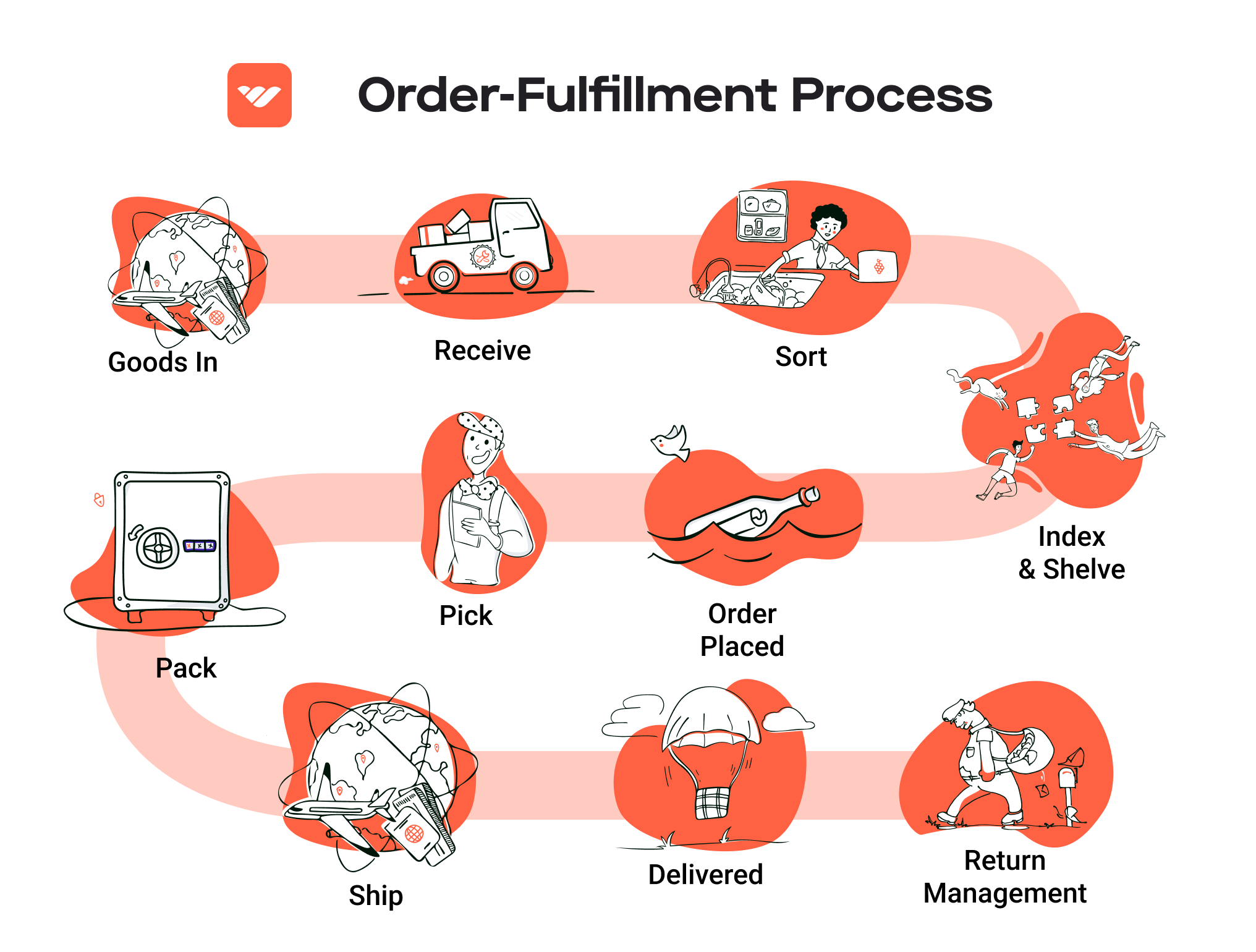
Comparing Fulfillment Models: In-House vs. 3PL vs. Dropshipping
Fulfillment Models Comparison
| Model | Who Handles Inventory | Best For (Business Stage) | Key Advantage | Key Disadvantage |
|---|---|---|---|---|
| In-House Fulfillment | The business itself | Established businesses | Full control over inventory | High operational costs |
| Third-Party Logistics (3PL) | A third-party provider | Growing and scaling businesses | Scalability and expertise | Less control over operations |
| Dropshipping | Suppliers/manufacturers | Startups and small businesses | Low startup costs and inventory risk | Lower profit margins and shipping delays |
In-House Fulfillment
In-house fulfillment involves managing the entire inventory and order processing within the business itself. This model is best suited for established businesses that have the resources and infrastructure to handle logistics internally. The key advantage of in-house fulfillment is the complete control it offers over the inventory, allowing businesses to maintain quality standards, customize packaging, and optimize shipping processes according to their unique needs. Furthermore, having direct oversight enables faster response times to customer queries and issues, enhancing the overall customer experience.
However, the downside to in-house fulfillment is the high operational costs associated with warehousing, staffing, and equipment. Businesses must invest significantly in infrastructure, which can be a burden, particularly for those with fluctuating order volumes. Additionally, as order volume grows, the complexity of managing fulfillment increases, requiring more sophisticated systems and processes. Thus, while in-house fulfillment offers control, it can be resource-intensive and may not be sustainable for businesses looking to scale quickly.
Third-Party Logistics (3PL)
Third-party logistics (3PL) involves outsourcing inventory management and order fulfillment to specialized logistics providers. This model is particularly beneficial for growing and scaling businesses that may not have the capacity to handle increased order volumes effectively. The key advantage of using a 3PL is scalability; businesses can quickly adjust their logistics capacity in response to market demand without the need to invest in additional infrastructure. Moreover, 3PL providers typically bring expertise in logistics and supply chain management, which can enhance operational efficiency and reduce shipping costs through established carrier relationships.
On the downside, utilizing a 3PL means relinquishing some control over inventory and fulfillment processes. This can lead to challenges such as miscommunication, shipping errors, and potential delays, which may negatively impact customer satisfaction. Furthermore, businesses must carefully select a reliable 3PL partner, as the success of this model heavily depends on the provider’s capabilities and reliability. For businesses that prioritize growth and efficiency, however, 3PL can be an effective solution to streamline operations and enhance scalability.
Dropshipping
Dropshipping is a fulfillment model where the retailer does not hold inventory but instead relies on suppliers to ship products directly to customers. This model is particularly appealing for startups and small businesses, primarily due to its low startup costs and minimal inventory risk. Entrepreneurs can launch e-commerce stores without the financial burden of purchasing inventory upfront, allowing them to focus on marketing and customer acquisition.
The key disadvantage of dropshipping is the lower profit margins compared to traditional retail models. Since retailers rely on suppliers for fulfillment, they often have limited pricing control and may face higher costs per unit. Additionally, shipping times can be longer, especially if suppliers are located overseas, which can lead to customer dissatisfaction. Furthermore, businesses have less control over product quality and inventory levels, which can result in stockouts or shipping errors that tarnish the brand’s reputation. Despite these challenges, dropshipping remains a viable option for those looking to enter the e-commerce space with minimal investment and risk.
A Deep Dive into Amazon FBA: Pros, Cons, and Who It’s For
Understanding Fulfillment by Amazon (FBA)
Fulfillment by Amazon (FBA) is a service that allows e-commerce businesses to outsource their order fulfillment processes to Amazon. Sellers send their products to Amazon’s fulfillment centers, and when a customer places an order, Amazon handles storage, packaging, and shipping. This service not only facilitates logistics but also provides sellers with access to Amazon’s vast customer base, enhancing visibility and sales potential.
How FBA Works
-
Setup: Sellers create an Amazon seller account and enroll in the FBA program. They then list their products on Amazon and specify that they want to use FBA.
-
Inventory Shipment: Sellers ship their products to Amazon’s fulfillment centers. It’s crucial to follow Amazon’s guidelines for packaging and labeling to ensure smooth processing.
-
Storage: Once the inventory arrives, Amazon stores the products in their fulfillment centers. Sellers can monitor their inventory levels through the Amazon Seller Central dashboard.
-
Order Processing: When a customer orders a product, Amazon picks, packs, and ships the item directly to the customer. Amazon also handles customer service and returns.
-
Fees: Sellers incur various fees, including storage fees for inventory held at Amazon’s fulfillment centers and fulfillment fees per unit sold.
-
Sales and Reports: Sellers can track their sales performance through detailed reports available in Seller Central, enabling them to manage inventory and optimize listings effectively.
Pros of Using FBA
1. Prime Eligibility
One of the most significant advantages of FBA is the eligibility for Amazon Prime. Products fulfilled through FBA are marked with the Prime logo, which can lead to increased visibility and sales. Prime members often prefer to purchase items eligible for fast, free shipping, which can significantly boost a seller’s sales volume.
2. Customer Trust
Amazon is synonymous with trust and reliability. By using FBA, sellers benefit from Amazon’s reputation, which can enhance customer confidence in their products. Customers are more likely to purchase from sellers who use FBA due to the assurance of Amazon’s customer service and return policies.
3. Multi-Channel Fulfillment
FBA is not limited to Amazon sales. Sellers can use FBA to fulfill orders from other sales channels, such as their own websites or other e-commerce platforms. This capability allows for streamlined operations and inventory management across multiple sales avenues.
4. Efficient Logistics
Amazon’s extensive fulfillment network allows sellers to reach customers quickly and efficiently. With over 1300 fulfillment centers globally, Amazon can offer expedited shipping options that many small and medium-sized businesses may struggle to replicate on their own.
5. Time Savings
Outsourcing order fulfillment to Amazon saves sellers time and resources that can be redirected toward marketing, product development, and other critical business activities. This allows businesses to scale more effectively without the burden of managing logistics.
Cons of Using FBA
1. High Fees
While FBA offers numerous benefits, it comes with a cost. Sellers are charged various fees, including monthly storage fees and fulfillment fees. These costs can accumulate quickly, especially for products that don’t sell as fast as anticipated, impacting profit margins.
2. Strict Inventory Rules
Amazon has stringent guidelines regarding inventory management. Sellers must adhere to specific requirements for labeling, packaging, and shipping products. Non-compliance can result in penalties, additional fees, or even account suspension, making it vital for sellers to be well-versed in Amazon’s rules.
3. Commingling Risks
Amazon’s FBA program commingles inventory from different sellers to streamline fulfillment. While this can lead to faster shipping times, it also poses a risk. If a customer receives a defective or counterfeit product, it may reflect poorly on the original seller, leading to negative reviews and potential account issues.
4. Limited Control Over Customer Experience
When using FBA, sellers relinquish control over the fulfillment process. This means that they cannot directly manage packaging or shipping, which may lead to inconsistencies in how their brand is represented. Additionally, customer service inquiries related to orders are handled by Amazon, which may not always align with the seller’s preferred approach.
Who is FBA Best For?
Fulfillment by Amazon is ideally suited for:
-
Small to Medium-Sized Businesses: Companies looking to scale without investing heavily in logistics and warehousing can benefit significantly from FBA’s services.
-
Online Retailers: E-commerce businesses that primarily sell on Amazon can leverage FBA to enhance their visibility and customer trust while focusing on marketing and sales growth.
-
Sellers with High Sales Volume: Businesses that have consistent sales and can manage inventory effectively will find the fees associated with FBA more manageable.
-
Brands Seeking Market Expansion: Companies looking to enter new markets or regions can utilize Amazon’s established network to reach customers without the need for local fulfillment infrastructure.
In summary, FBA can be a powerful tool for e-commerce businesses aiming to streamline logistics, enhance customer trust, and increase sales. However, it’s essential to weigh the benefits against the associated costs and operational complexities to determine if it aligns with your business strategy.
Core Services Offered by Fulfillment Centers
Inventory Management & Warehousing
Inventory management and warehousing are foundational services provided by fulfillment centers that significantly enhance operational efficiency for e-commerce businesses. This service involves the systematic tracking and storage of goods within a fulfillment center, ensuring that products are organized and readily available for order fulfillment.
What It Is:
Fulfillment centers utilize advanced inventory management systems to monitor stock levels, manage reorders, and maintain accurate records of inventory. These systems can often integrate with e-commerce platforms, providing real-time data about inventory status. Warehousing services include climate-controlled storage options, security measures, and efficient layout designs to optimize space and accessibility.
Benefits:
1. Improved Accuracy: Automated inventory management reduces human error, ensuring that stock levels are accurate and up-to-date. This minimizes the risk of overselling or running out of stock.
2. Cost Efficiency: By outsourcing warehousing, businesses can save on overhead costs associated with maintaining their own storage facilities, including rent, utilities, and staffing.
3. Scalability: As businesses grow, fulfillment centers can easily adjust storage space and inventory management systems to accommodate increased product lines or seasonal fluctuations.
4. Enhanced Order Fulfillment Speed: With a well-organized warehouse, products can be located and retrieved more quickly, leading to faster shipping times and improved customer satisfaction.
Pick and Pack Services
Pick and pack services are crucial for ensuring that orders are fulfilled accurately and efficiently. This process involves selecting items from inventory (picking) and packaging them appropriately for shipping (packing).
What It Is:
In a typical pick and pack operation, fulfillment center staff receive orders and use inventory management systems to locate the required items. Once gathered, the products are carefully packed into shipping boxes, often with protective materials to prevent damage during transit. This service may also include labeling and documentation for shipping.
Benefits:
1. Time Savings: Outsourcing pick and pack services allows businesses to focus on core activities like marketing and product development, rather than logistics.
2. Customization: Many fulfillment centers offer customizable packing options, including branded packaging, which can enhance the customer experience and improve brand recognition.
3. Error Reduction: Fulfillment centers implement quality control checks during the picking and packing process, significantly reducing the likelihood of shipping incorrect items.
4. Scalability: As order volumes fluctuate, fulfillment centers can quickly scale their pick and pack operations to meet demand, ensuring that businesses can respond to market changes without delay.
Kitting and Assembly
Kitting and assembly services provide e-commerce businesses with the ability to bundle products or assemble items before they are shipped to customers. This service is particularly beneficial for companies offering multi-item products or those requiring assembly.
What It Is:
Kitting involves grouping multiple products together to create a single SKU, while assembly refers to the construction of a product from its individual components. Fulfillment centers often have the resources and expertise to perform these tasks efficiently, ensuring that products are ready for sale upon delivery.
Benefits:
1. Streamlined Operations: By outsourcing kitting and assembly, businesses can eliminate the need for in-house labor and equipment, which can be costly and time-consuming.
2. Enhanced Customer Experience: Providing customers with ready-to-use products can lead to higher satisfaction rates, as they receive exactly what they expect without the need for additional assembly.
3. Inventory Management Simplification: Bundling products into kits simplifies inventory management, as businesses can track fewer SKUs while still offering a variety of product options.
4. Cost Efficiency: Fulfillment centers can often procure materials and manage labor more efficiently than an individual business, leading to cost savings that can be passed on to customers.
Returns Management (Reverse Logistics)
Returns management, or reverse logistics, is an essential service for e-commerce businesses that helps streamline the process of handling product returns. Given the increasing importance of customer satisfaction in the online shopping experience, effective returns management is critical.
What It Is:
This service encompasses all aspects of managing returned goods, including processing returns, restocking items, and handling defective products. Fulfillment centers typically have established procedures to assess the condition of returned items and determine their next steps, whether that involves restocking, refurbishing, or recycling.
Benefits:
1. Customer Retention: A hassle-free returns process enhances customer trust and satisfaction, encouraging repeat purchases and positive reviews.
2. Operational Efficiency: By outsourcing returns management, businesses can streamline their operations, ensuring that returned products are quickly assessed and processed without disrupting regular order fulfillment.
3. Data Insights: Fulfillment centers can provide valuable insights into return trends and reasons, enabling businesses to make informed decisions about product quality, customer service, and inventory management.
4. Cost Savings: Efficient returns processing can reduce the costs associated with handling returns, such as shipping and restocking fees, ultimately contributing to a healthier bottom line.
In conclusion, partnering with a fulfillment center that offers these core services can significantly enhance the operational capabilities of e-commerce businesses. By leveraging specialized expertise in inventory management, pick and pack services, kitting and assembly, and returns management, businesses can focus on growth while ensuring a seamless customer experience.
How to Choose a Fulfillment Partner: A 6-Point Checklist
Location & Warehouse Network
When selecting a fulfillment partner, the geographical location of their warehouses plays a crucial role in your logistics efficiency. A well-distributed network can significantly reduce shipping times and costs, enhancing customer satisfaction.
Questions to Ask:
– Where are your fulfillment centers located, and how does this align with my target market?
– What is the average shipping time from your warehouses to key locations?
– Do you have facilities that can support my business in international markets if I choose to expand?
Technology & Integrations
In today’s digital age, the technology used by a fulfillment partner can make or break your operations. A robust fulfillment system that integrates seamlessly with your e-commerce platform is essential for real-time inventory management, order tracking, and accurate reporting.
Questions to Ask:
– What technology platforms do you use for order management and inventory tracking?
– Can your system integrate with my current e-commerce software (e.g., Shopify, WooCommerce)?
– Do you offer APIs for further customization and integration?
Specializations (e.g., Cold Storage, Oversized Items)
Depending on your product offerings, you may require specific storage solutions. If you sell perishable goods, for example, a partner with cold storage capabilities is necessary. Similarly, oversized items might require specialized handling and storage.
Questions to Ask:
– What special services do you offer for specific product types (e.g., cold storage, hazardous materials, oversized items)?
– How do you handle inventory that requires specific conditions (e.g., temperature control)?
– Can you manage returns for specialized items, and what is your process for that?
Scalability & Capacity
As your business grows, your fulfillment needs will likely change. It’s vital to choose a partner who can scale with you, accommodating spikes in demand without compromising service quality.
Questions to Ask:
– What is your current capacity, and how quickly can you scale operations if my order volume increases?
– Do you have seasonal flexibility to handle peak times, such as holidays or sales events?
– What infrastructure do you have in place to support rapid growth (e.g., workforce, technology upgrades)?
Pricing and Contracts
Understanding the pricing structure and contract terms is essential to avoid unexpected costs that could erode your margins. Transparent pricing helps you forecast expenses more accurately.
Questions to Ask:
– What is your pricing model (e.g., per order, per item, storage fees), and are there any hidden costs I should be aware of?
– How do you handle price increases, and how often do they occur?
– What are the contract terms, and is there flexibility for renegotiation as my business evolves?
Customer Support & Reviews
The level of customer support provided by your fulfillment partner can significantly impact your operations. Responsive and knowledgeable support can help resolve issues quickly and maintain your customer satisfaction.
Questions to Ask:
– What support options do you offer (e.g., phone, email, chat), and what are your response times?
– Can you provide references or testimonials from current clients?
– How do you handle issues or disputes, and what is your process for escalation?
Conclusion
Choosing the right fulfillment partner is a critical decision that can influence your e-commerce business’s success. By evaluating potential partners using this checklist, you can ensure that you select a fulfillment solution that aligns with your operational needs and growth objectives. Take the time to ask the right questions and conduct thorough research to establish a partnership that will enhance your logistics capabilities and improve your customer experience.
Understanding Fulfillment Pricing: A Breakdown of Common Fees
Initial Setup Fees
When partnering with a fulfillment center, businesses often encounter initial setup fees. These fees are charged to cover the costs associated with onboarding a new client. The setup process typically includes account creation, integration with existing e-commerce platforms, and system configuration.
The calculation of these fees can vary widely based on the complexity of the integration and the specific requirements of the business. Some fulfillment centers may offer a flat rate, while others might charge based on the number of SKUs or the volume of expected shipments. It’s essential to inquire about the specifics of what the setup fee includes to avoid unexpected costs.
Receiving Fees
Receiving fees are incurred when the fulfillment center accepts inventory shipments. This fee covers the labor and equipment costs associated with unloading, checking, and placing inventory into storage.
Typically, receiving fees are calculated per shipment or based on the total weight or volume of the goods being received. For example, a fulfillment center may charge a standard fee for the first 500 pounds of goods, with additional charges for every subsequent 100 pounds. Understanding the receiving fee structure is crucial for planning inventory shipments, as these costs can add up quickly, especially for businesses that frequently replenish stock.
Storage Fees (per pallet/bin)
Storage fees are charged for the space that your inventory occupies within the fulfillment center. These fees can be calculated on a monthly basis and are often based on the number of pallets or bins your inventory fills.
There are two common pricing models for storage fees: a flat monthly rate per pallet/bin or a tiered system where the rate decreases as the quantity of stored pallets increases. Additionally, some fulfillment centers may implement long-term storage fees for items that remain in storage for extended periods, usually over six months. Businesses should analyze their inventory turnover rates to optimize storage costs and minimize fees associated with excess inventory.
Pick & Pack Fees (per item/order)
Pick and pack fees are charged for the process of retrieving items from storage and packaging them for shipment. This fee is typically calculated based on the number of items picked and packed per order.
Fulfillment centers may charge a flat fee per order, a variable fee based on the number of items, or a combination of both. For instance, a fulfillment center might charge a base fee for the first item and an additional fee for each subsequent item in the order. Understanding the pick and pack fee structure is essential for businesses, particularly those with a diverse product range, as it directly impacts the overall fulfillment costs.
Shipping Fees
Shipping fees cover the cost of transporting the packaged orders to customers. These fees can be one of the most significant expenses in the fulfillment process, and they are typically calculated based on factors such as the weight and dimensions of the package, the shipping method selected (standard, expedited, etc.), and the destination.
Many fulfillment centers have partnerships with major carriers, allowing them to negotiate discounted shipping rates. Businesses should inquire about the fulfillment center’s shipping options, as well as their ability to pass on those discounts. Additionally, some centers may offer flat-rate shipping for certain regions, which can help businesses predict their shipping expenses more accurately.
Tips for Getting an Accurate Quote
To ensure you receive an accurate quote from a fulfillment center, consider the following tips:
-
Provide Detailed Information: Clearly outline your inventory types, expected order volumes, and any special handling requirements. The more specific you are, the better the fulfillment center can tailor their services to your needs.
-
Ask About All Fees: Inquire about all potential fees, including setup, receiving, storage, pick and pack, and shipping. Understanding the complete cost structure will help you avoid surprises later.
-
Request a Breakdown: Ask for a detailed breakdown of costs associated with each fee type. This will allow you to identify areas where you can potentially reduce costs.
-
Compare Multiple Providers: Don’t settle for the first quote you receive. Compare multiple fulfillment centers to find the best value for your specific needs.
-
Negotiate: Depending on your order volume, you may have room to negotiate fees. Many fulfillment centers are open to adjusting their pricing for larger clients.
By understanding these common fulfillment pricing models and following these tips, e-commerce businesses can make informed decisions that align with their operational goals and budget constraints.
Frequently Asked Questions (FAQs) about Fulfillment
1. What are Amazon fulfillment centers?
Amazon fulfillment centers are large warehouses where Amazon stores products for sellers who use its Fulfillment by Amazon (FBA) service. These centers handle inventory management, order processing, packaging, and shipping, allowing sellers to reach customers more efficiently.
2. How many Amazon fulfillment centers are there?
As of 2025, there are over 1,300 Amazon fulfillment centers worldwide. This extensive network enables Amazon to offer quick delivery options, such as same-day and two-day shipping, across various regions.
3. What is the difference between a warehouse and a fulfillment center?
A warehouse is primarily used for storage, while a fulfillment center is designed for the entire process of fulfilling customer orders, including inventory management, order picking, packing, and shipping. Fulfillment centers typically have advanced technology and processes to streamline order processing.
4. How do I choose the right Amazon fulfillment center for my business?
When selecting a fulfillment center, consider factors such as location, shipping speed, cost, and the types of products you sell. Choosing a center closer to your customer base can reduce shipping times and costs.
5. What is a 3PL?
A Third-Party Logistics (3PL) provider is a company that offers outsourced logistics services, including warehousing, fulfillment, and transportation. While Amazon’s FBA is a form of 3PL, businesses can also partner with other 3PL providers for additional flexibility and services tailored to their needs.
6. How much do fulfillment services cost?
Fulfillment costs can vary based on several factors, including the volume of orders, size and weight of products, and specific services required (e.g., storage fees, picking and packing fees, and shipping rates). Amazon provides a fee structure for FBA, which includes storage fees and fulfillment fees per unit sold.
7. How does Amazon’s fulfillment network support scalability?
Amazon’s extensive fulfillment network allows businesses to scale by efficiently handling increased order volumes. By leveraging Amazon’s infrastructure, sellers can expand their reach without investing in their own warehousing or logistics capabilities.
8. Can I use Amazon fulfillment centers for international shipping?
Yes, Amazon offers international fulfillment options through its Global Selling program. Sellers can use Amazon’s fulfillment centers in various countries to reach customers worldwide, benefiting from Amazon’s logistics expertise.
9. What types of products are best suited for Amazon fulfillment centers?
Generally, fast-moving consumer goods, electronics, apparel, and household items are well-suited for Amazon fulfillment centers. However, sellers should consider factors such as size, weight, and seasonality when determining product suitability.
10. How do I manage inventory in Amazon fulfillment centers?
Sellers can manage their inventory through the Amazon Seller Central platform, where they can track stock levels, set reorder alerts, and analyze sales data. Effective inventory management is crucial to avoiding stockouts and ensuring timely order fulfillment.
Conclusion: Is Outsourcing Fulfillment the Right Move for Your Business?
Evaluating the Benefits of Outsourcing Fulfillment
Outsourcing fulfillment can be a game-changer for e-commerce businesses aiming to scale efficiently. By leveraging a fulfillment service, businesses can save significant time and resources. This allows owners and managers to redirect their focus toward strategic initiatives such as product development, marketing, and customer engagement, rather than getting bogged down in the complexities of logistics.
Scalability is another compelling advantage. As your sales volume increases, the ability to seamlessly scale your fulfillment operations can be a crucial differentiator. With a fulfillment partner, you gain access to a robust infrastructure that can accommodate fluctuating demand, seasonal spikes, and new market entries without the need for substantial capital investment in warehousing or staffing.
Moreover, partnering with an experienced fulfillment provider brings specialized expertise to your operations. These partners understand the intricacies of logistics, from inventory management to shipping regulations, ensuring that your products reach customers efficiently and compliantly. This expertise can enhance customer satisfaction, leading to repeat business and positive word-of-mouth.
However, the key to maximizing these benefits lies in choosing the right fulfillment partner. A misaligned partnership can lead to operational headaches and customer dissatisfaction. Therefore, it’s essential to assess potential partners based on their capabilities, technology, and alignment with your business goals.
Take Action: Audit Your Shipping Process
Now is the time to evaluate whether outsourcing fulfillment is the right move for your business. Conduct a thorough audit of your current shipping process, identifying pain points and areas where you could benefit from external expertise. This proactive step could reveal opportunities to streamline operations, improve service levels, and ultimately drive growth. Don’t hesitate—take the first step toward transforming your logistics strategy today.
Important Disclaimer
⚠️ Important Disclaimer
The information in this guide is for educational purposes. Fulfillment services, pricing, and platform features change frequently. Always conduct your own due diligence and consult with providers directly before making business decisions.
